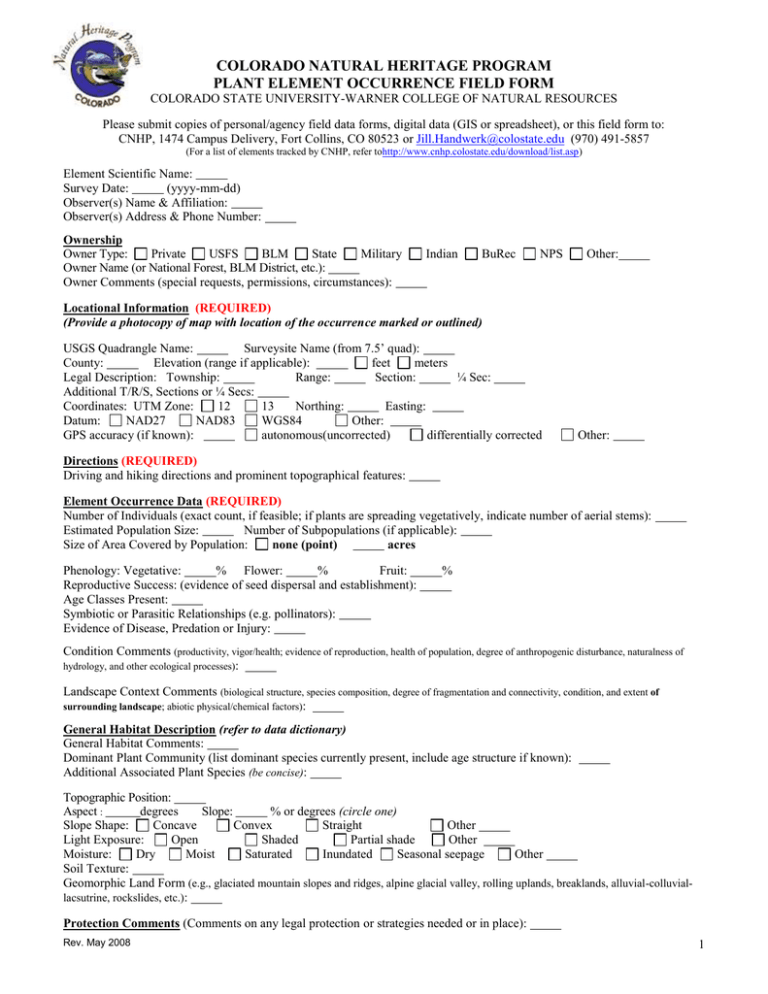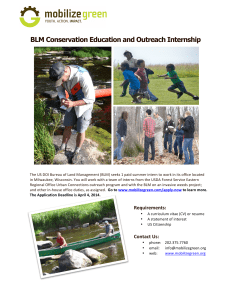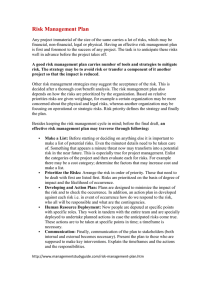Download Word Form
advertisement

COLORADO NATURAL HERITAGE PROGRAM PLANT ELEMENT OCCURRENCE FIELD FORM COLORADO STATE UNIVERSITY-WARNER COLLEGE OF NATURAL RESOURCES Please submit copies of personal/agency field data forms, digital data (GIS or spreadsheet), or this field form to: CNHP, 1474 Campus Delivery, Fort Collins, CO 80523 or Jill.Handwerk@colostate.edu (970) 491-5857 (For a list of elements tracked by CNHP, refer tohttp://www.cnhp.colostate.edu/download/list.asp) Element Scientific Name: Survey Date: (yyyy-mm-dd) Observer(s) Name & Affiliation: Observer(s) Address & Phone Number: Ownership Owner Type: Private USFS BLM State Military Owner Name (or National Forest, BLM District, etc.): Owner Comments (special requests, permissions, circumstances): Indian BuRec NPS Other: Locational Information (REQUIRED) (Provide a photocopy of map with location of the occurrence marked or outlined) USGS Quadrangle Name: Surveysite Name (from 7.5’ quad): County: Elevation (range if applicable): feet meters Legal Description: Township: Range: Section: ¼ Sec: Additional T/R/S, Sections or ¼ Secs: Coordinates: UTM Zone: 12 13 Northing: Easting: Datum: NAD27 NAD83 WGS84 Other: GPS accuracy (if known): autonomous(uncorrected) differentially corrected Other: Directions (REQUIRED) Driving and hiking directions and prominent topographical features: Element Occurrence Data (REQUIRED) Number of Individuals (exact count, if feasible; if plants are spreading vegetatively, indicate number of aerial stems): Estimated Population Size: Number of Subpopulations (if applicable): Size of Area Covered by Population: none (point) acres Phenology: Vegetative: % Flower: % Fruit: Reproductive Success: (evidence of seed dispersal and establishment): Age Classes Present: Symbiotic or Parasitic Relationships (e.g. pollinators): Evidence of Disease, Predation or Injury: % Condition Comments (productivity, vigor/health; evidence of reproduction, health of population, degree of anthropogenic disturbance, naturalness of hydrology, and other ecological processes): Landscape Context Comments (biological structure, species composition, degree of fragmentation and connectivity, condition, and extent of surrounding landscape; abiotic physical/chemical factors): General Habitat Description (refer to data dictionary) General Habitat Comments: Dominant Plant Community (list dominant species currently present, include age structure if known): Additional Associated Plant Species (be concise): Topographic Position: Aspect : degrees Slope: % or degrees (circle one) Slope Shape: Concave Convex Straight Other Light Exposure: Open Shaded Partial shade Other Moisture: Dry Moist Saturated Inundated Seasonal seepage Other Soil Texture: Geomorphic Land Form (e.g., glaciated mountain slopes and ridges, alpine glacial valley, rolling uplands, breaklands, alluvial-colluviallacsutrine, rockslides, etc.): Protection Comments (Comments on any legal protection or strategies needed or in place): Rev. May 2008 1 Management Comments Evidence of Threats and Disturbance (e.g. effects on population viability due to mining, recreation, grazing, exotic species; past/present/future recommendations): Predominant Land Uses: Exotic Species: Documentation Photographs Taken: Specimens Taken: Y Y N Photographer: N Collector: Photo Number(s): Collection Number(s): Repository: Repository: General Comments Rev. May 2008 2


